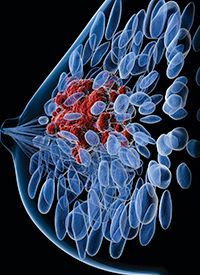Article
Breast Cancer Survivors Need More Tailored Follow-Up Care
Author(s):
Post-treatment care for breast cancer survivors must be personalized to address each survivor’s unique experiences.

Post-treatment care for breast cancer survivors must be personalized to address each survivor’s unique experiences, according to a study presented at the ESMO Breast Cancer Virtual Congress 2021. Women in the low- and intermediate-burden subgroups had symptom scores better or equal to the average Dutch woman but many in the high-burden subgroup were significantly worse than average for all 11 symptoms evaluated.1
The low subgroup reported a lower symptom burden compared to the general population. The intermediate subgroup experienced burden similar to the general population, although scores for fatigue, insomnia, and cognitive symptoms were slightly worse.
Symptom burden in the high subgroup was significantly than the general population. Compared with the intermediate subgroup, patients in the high burden group were more likely to have at least 1 comorbidity (relative risk ratio (RRR), 2.75; 95% CI, 1.22-6.19; P = .015) and more likely to have multiple comorbidities (RRR, 9.19; 95% CI; 3.70-22.8; P <.001).
“I was pleasantly surprised to find that so many survivors were doing as well or even better than the average Dutch woman,” lead author Kelly de Ligt, PhD, from the Netherlands Cancer Institute in Amsterdam, said in a news release.
de Ligt added that the findings in the high-burden subgroup were alarming. “This was the smallest group, only 15% of our population, but nonetheless, 1 in 6 women in our study had worse scores than the general population for all symptoms. The differences, ranging between 15 and 20 percentage points, were large enough to be considered not just statistically significant, but clinically relevant as well.”
More and more women are living longer following a diagnosis of breast cancer. The 10-year survival rate is greater than 70% in Europe and 84% for non-metastatic invasive disease in the United States.2,3 Quality of life is extremely important for these patients and de Ligt said these findings confirm the necessity for personalized approaches to the follow-up of cancer patients, some of whom still require special attention as long as 5 years after diagnosis.
de Ligt and her colleagues surveyed 404 women who received surgery with or without adjuvant treatment for stage I to III breast cancer selected from the Netherlands Cancer Registry. Participants were 1 to 5 years postdiagnosis and compared with a representative sample of 1300 women from the general population.
Investigators assessed participants for fatigue, nausea, pain, dyspnea, insomnia, appetite, constipation, diarrhea, financial burden, and emotional and cognitive symptoms on a scale 0-100 through the EORTC-QLQ-C30. Participants were then segregated into low- (28.7%), intermediate- (55.4%), and high-burden groups (14.6%) based on their responses.
de Ligt and her team also determined that patients with comorbidities such as heart disease and diabetes were more likely to experience a high symptom burden. de Ligt said the association was so strong that investigators could not connect the level of symptom burden with the type of therapy received.
“Future research should attempt to measure patients’ health-related quality of life through Patient Reported Outcome Measures (PROMs) before the start of treatment for breast cancer and afterwards to allow us to measure the effect of the therapy,” she said.
References
- de Light KM, de Rooij BH, Walraven I, et al. Towards tailored follow-up care for breast cancer survivors: cluster analyses based on symptom burden. Presented at: ESMO Breast Cancer Virtual Congress 2021. Abst # 134P_PR. https://bit.ly/3b1bgHN
- Cardoso F, Kyriakides S, Ohno S, et al. Early breast cancer: ESMO clinical practice guidelines for diagnosis, treatment and follow up. Ann Oncol. 2019;30(8):1194-1220. doi:org/10.1093/annonc/mdz173
- Breast cancer: statistics. Cancer.net. January 2021. Accessed May 4, 2021. https://www.cancer.net/cancer-types/breast-cancer/statistics









